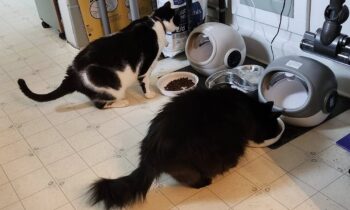
Last week, we talked about outmoded methods of training—methods that might physically harm dogs and methods that certainly could change an owner’s relationship with his dog . . . and not for the better. If punitive methods have been proven ineffective and potentially harmful, what are our alternatives?
First, do no harm.
Perhaps you know these words as the motto of physicians, but they are equally meaningful to dog trainers, class instructors, and behavior specialists. We deal with two species—canine and human. In many ways, we act as advocates for the canine side of the relationship, speaking for the one who can’t speak for himself. I’m not saying we read dog minds. I’m saying we read dogs.
If we misread dogs—if we misunderstand what they are saying, what their behavior communicates—we do both the canine and the human a great disservice. Each dog and each human is different. One size does not fit all. Our job is to help individual owners and dogs find what works best for them without taking any chances that our guidance will make their relationship worse, not better.
From personal experience and from the experiences of others—shared through books, videos, and online, through classes and seminars, through apprenticing and mentoring—we know that positive methods work and punitive methods do not. We know that positive methods meet our goal of first doing no harm. We know that people in general would much rather reward their dogs for making good choices than punish their dogs for making bad choices.
Behavior that is rewarded will continue.
Behavior that is not rewarded will diminish.
That’s it, in a nutshell—scientifically.

Last week, I described what it might be like for you and for your dog to attend a training class where outmoded methods were used exclusively. Now I’d like to describe a training class you might attend today. One big difference: your dog will still be a puppy when you start training.
If you’re old enough, you might remember when it was impossible to find a training class that accepted dogs under six months of age. In fact, owners were advised, back in the day, not to attend training classes with puppies. Some veterinarians even advised waiting to take your puppy out in public until the puppy had a complete set of shots, including rabies, which is not given until six months of age. Breeders might hold “puppy parties” to socialize litters while they were still with their dam, but once the pups went home with new owners, it was a long wait to start any training.
Fortunately for us and our dogs, that is very different now.
Today, puppy classes are often open to any puppy under four or four-and-a-half months of age, with more advanced training available for puppies after their first class, usually up to six months of age. Veterinarians now encourage attendance at puppy classes soon after a pup has had initial age-appropriate shots and a well-puppy examination. Puppy classes are so popular, it’s wise to sign your puppy up as soon as you know when she’ll be coming home, to make sure she has a place in a class when she is ready. Puppy classes are now considered the most valuable training classes of a dog’s life, and the best investment of the owners’ time and effort (not to mention class fees).
The first night of a puppy class normally takes place without the puppies.
Does that sound strange? Not at all—it’s orientation for the owners. Imagine a classroom full of puppies who have just seen their first classroom of puppies! To make sure you know what to do when you do bring your puppy, you’ll have a calm and well-organized introduction the first week without her. You’ll get lots of information that you’ll be able to use right away about housebreaking, crating, feeding, and socialization. You’ll take home lots of hand-outs. You’ll probably be advised to watch specific short videos online. You’ll likely be given a book list. You’ll meet the other students in your class.
In later classes, one important aspect will be to discover the equipment you’ll need for your dog, both right away and as she grows up. Choosing a leash and collar, head collar, or harness will be discussed at length, with demonstrations on various dogs. Your puppy may be allowed to “try on” different choices to see, right there in class, how each works for you and her.
Rewards are another subject that puppy class will cover—one that your puppy and you are certain to enjoy. Again, experimenting will be encouraged. You’ll have a chance to see what works for each puppy in the class, and maybe even share shopping tips or recipes for homemade treats. In many ways, puppy class becomes a support group for puppy owners, where each human discovers that his or her puppy, although an individual, is probably quite normal, no matter what’s happening at home.
Puppy classes are hands-on for all participants.
Socialization is a critical part of a good puppy class.
Puppy-class instructors usually encourage families to bring children who are old enough and responsible enough to behave appropriately in a class situation. Children make great dog trainers, and puppy class is their place to shine. For puppies without kids at home, puppy class is a great opportunity to have good first experiences with youngsters in a controlled and safe environment. Teenagers are always welcome and rival their younger siblings in interest. Puppy class is truly a family class.
When you get to the end of a good puppy class, you will find many owners signing up their pups for the next class series on the schedule. They want to keep having fun and learning with their pups. That’s the sign of a good class and good instructors: student retention. Not only do most who start finish the class, but many immediately go on to the next class for which they can register.
In a group with six to eight puppies and their families, everyone—puppies and people—is happy. They feel a sense of accomplishment. They can’t believe how much they’ve learned. They want to keep going and learn even more. They’ve succeeded. They can see it works and they can do it!
What about dogs who are too old for puppy classes?
Surprisingly enough, beginning classes for older dogs without any training yet are usually very similar to puppy classes, without the puppy playtimes. If you’ve just adopted a dog who’s over six months old (especially if you’re not experienced with dogs in general), you will be best off in a training class that starts off with the basics—teaching basic behaviors and how to live happily with a dog.
Should your dog have “issues”—for instance, extreme shyness or fear, rough behavior or potential aggression with other dogs, aggression that’s displaced to humans—you will be directed at the start to an appropriate class, or even individual instruction, that is most appropriate to your dog’s situation. In that class, your dog’s issues will be dealt with through methods that are never punitive and never physically hurtful to the dog. Instead, you will be offered many positive options and coached carefully as you work through the steps. Your instructors will be available to answer your questions, to listen to your concerns. You’ll be working as a team to make your dog’s life better.
Puppy classes and beginning training—how do you find a good class?
Next week, we’ll talk about what to look for in dog-training instruction.



